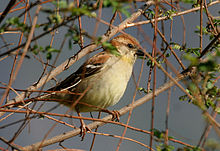- Russet Sparrow
-
Russet Sparrow 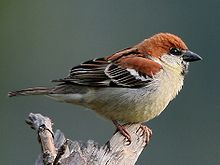
Male in Kullu, India Conservation status Scientific classification 
Kingdom: Animalia Phylum: Chordata Class: Aves Order: Passeriformes Family: Passeridae Genus: Passer Species: P. rutilans Binomial name Passer rutilans
(Temminck, 1835)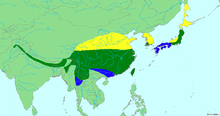
Yellow – summer range
Blue – winter range
Green – year-round rangeSynonyms Fringilla rutilans Temminck, 1835
Pyrgita cinnamomea Gould, 1836
Passer russatus Temminck and Schegel, 1850The Russet Sparrow (Passer rutilans), also called the Cinnamon or Cinnamon Tree Sparrow, is a passerine bird of the sparrow family Passeridae. A chunky little seed-eating bird with a thick bill, it has a body length of 14–15 cm (5.5–5.9 in). Its plumage is mainly warm rufous above and grey below. It exhibits sexual dimorphism, with the plumage of both sexes patterned similarly to that of the corresponding sex of House Sparrow. Its vocalisations are sweet and musical chirps, which when strung together form a song.
Three subspecies are recognised, differing chiefly in the yellowness of their underparts. The subspecies rutilans and intensior breed in parts of eastern Asia, where they are usually found in light woodland, and the subspecies cinnamomeus breeds in the Himalayas, where it is usually associated with terrace cultivation. The Russet Sparrow is the typical sparrow of human habitations in towns where the House and Eurasian Tree sparrows are absent. In the southern part of its range, the Russet Sparrow prefers higher altitudes, but in the north it breeds by the sea. The Russet Sparrow is known well enough in the Himalayas to have a distinct name in some languages, and is depicted in Japanese art.
This sparrow feeds mainly on the seeds of herbs and grains, but it also eats berries and insects, particularly during the breeding season. This diet makes it a minor pest in agricultural areas, but also a predator of insect pests. While breeding, it is not social, as its nests are dispersed. It forms flocks when not breeding, although it associates with other bird species infrequently. In some parts of its range, the Russet Sparrow migrates, at least to lower altitudes. Its nest is located in a tree cavity, or a hole in a cliff or building. The male chooses the nest site before finding a mate and uses the nest for courtship display. The typical clutch contains five or six whitish eggs. Both sexes incubate and feed the young.
Contents
Description
The Russet Sparrow is a small chunky bird, with plumage warm rufous in overall colour. It is a medium-sized sparrow at 14–15 cm (5.5–5.9 in) and 18 to 22.5 grams (0.63–0.79 oz).[2][3] It has a thick bill suited to eating seeds, which is black on the breeding male, horn-coloured on the non-breeding male, and yellowish with a dark tip on the female.[4] Wingspans for males range between 6.8–8.2 cm (2.7–3.2 in) and those for females from 6.7–7.7 cm (2.6–3.0 in). Tail, bill, and tarsus lengths are 4.3–5.1 cm (1.7–2.0 in), 1.1–1.3 cm (0.43–0.51 in), and 1.6–1.8 cm (0.63–0.71 in), respectively.[2][3] Measurements for the Russet Sparrow vary geographically, between the three subspecies and also within the Himalayan subspecies cinnamomeus. The subspecies cinnamomeus is generally larger than the others, and within this form there is a tendency for birds at higher altitudes to be larger, and a clinal variation in size with the smallest birds in the west of the range and the largest in the east.[5] The iris is chestnut in colour.[6] The legs of both sexes are pale brown to pinkish-brown.[4] The flight of all sparrows is swift,[7] and that of the Russet Sparrow is described as swifter and more direct than that of the Eurasian Tree Sparrow.[8]
The sexes differ, or are dimorphic, in their plumage, and have a similar pattern to that in the corresponding sex of House Sparrow.[2][3] There is some variation between the three subspecies, especially in the colouration of the underparts.[2] Birds of the subspecies rutilans are off-white on their cheeks and the sides of their necks, and have pale grey underparts.[2] Birds of the subspecies intensior have a pale yellow wash on their underparts and cheeks, as well as darker upperparts,[2] while those of the subspecies cinnamomeus have a heavy yellow tinge to their underparts.[9] Moult is poorly recorded, the only records coming from Sakhalin and Himachal Pradesh. Like all other sparrows, the Russet Sparrow has a post-juvenile moult which is complete.[10] In Sakhalin, moult occurs in August and September, between the breeding season and the autumn migration.[10] In Himachal Pradesh, aviculturalist G. A. Perreau observed captive and wild birds and reported that they were yellow from December to spring and whitish during the remainder of the year, a pattern which may be atypical.[11]
The breeding male is bright russet or cinnamon red on its upperparts from its crown to its rump, with a black streaking on its mantle. It has a small black bib and black around its eye, separated from the russet of its crown by a very thin white supercilium, a stripe running from the bill to the rear of the head.[2] The side of its neck and cheek are off-white, and its underparts are pale grey or washed with yellow, varying geographically. Shoulders and greater coverts are chestnut, and its median coverts are black at the base with white at the tips. The rest of the wing is light brown with black tinges.[2][3][12] Its tail is blackish brown, edged with ashy brown.[6] The non-breeding male differs little from the breeding male,[13] being paler with more orange upperparts.[2][3] The only species with which the male is easily confused is the Eurasian Tree Sparrow, which differs in its black cheek spot and brown back.[14] The female has mostly pale brown upperparts, and pale grey underparts, so it resembles the female House Sparrow. It differs from the House Sparrow in its slightly darker, russet-tinged plumage. It has a conspicuous cream supercilium from above its eye nearly around its head, and a bold dark brown stripe through its eye. It has mostly greyish brown wings and a back streaked with black and buff.[2][3] The juvenile is similar to the female, though more pale and sandy. As the male reaches its first winter, it resembles the adult, differing in less bold chestnut and a dusky bib.[2][3]
Voice
The Russet Sparrow's vocalisations are described by most sources as "the sweetest and most musical" of any sparrow.[10] Its basic call is a cheep or chilp, similar to that of other sparrows. This call is monosyllabic, unlike the House Sparrow's chirrup call, and is softer than that of the other sparrows.[10] This call is given as a flight call, or by displaying males. Recorded variations include a chweep given by males at the nest and a trilled cheeep.[10] Sometimes the male strings calls together and sings them in a strident tone, to create a sort of short song, transcribed as cheep chirrup cheeweep or chreet-chreet-chreet. The song is interspersed with sibilant chu-swik notes similar to those of the White Wagtail.[10][15] A thin swee swee vocalisation not unlike that of an Indian Robin has been reported, but the context of this call is unrecorded.[10][15] During territorial disputes, males give a rapid chit-chit-chit call.[10]
Taxonomy
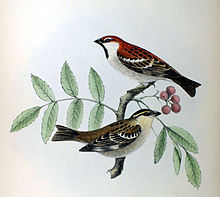 An illustration by Philipp Franz von Siebold from Fauna Japonica, in which the Russet Sparrow was described with the now synonymised name Passer russatus
An illustration by Philipp Franz von Siebold from Fauna Japonica, in which the Russet Sparrow was described with the now synonymised name Passer russatus
The Russet Sparrow was first scientifically described, as Fringilla rutilans, by the Dutch zoologist Coenraad Jacob Temminck in 1835, from a specimen collected in Japan.[3] Its specific name comes from the Latin rutilus, "of a glowing or auburn red".[16] It has usually been placed in the genus Passer, and within this genus it is seen as a part of the "Palearctic black-bibbed sparrow" group, which includes the Eurasian Tree Sparrow as well as the House Sparrow. It has generally been seen as a close relation of the House Sparrow, and Richard Meinertzhagen even considered it to be the same species as the Somali Sparrow, one of the House Sparrow's closest relatives.[3][17] However, studies of mitochondrial DNA indicate that the Russet Sparrow is an early offshoot or basal species among the Palearctic black-bibbed sparrows.[18][19] While mitochrondrial DNA suggest speciation in Passer occurred during the Miocene and Pliocene,[18] British ornithologist J. Denis Summers-Smith considers the Russet Sparrow to have separated from the other Palearctic black-bibbed sparrows about 25,000 to 15,000 years ago, during the last glacial period. During this time, sparrows would have only been found in isolated ice-free refugia, such as the lower Yangtze valley, which Summers-Smith considers the most likely centre of evolution for the Russet Sparrow.[4][20]
Thirteen subspecies have been described, but only three are widely recognised, these differing largely in the colour of their underparts.[2][5] The nominate subspecies Passer rutilans rutilans breeds in Japan, Korea, Taiwan, and southeastern and central China.[5] The subspecies intensior, described in 1922 by Walter Rothschild from Yunnan, breeds in southwest China and parts of India, Burma, Laos, and Vietnam.[5][21][22] In a large part of Sichuan intensior intergrades with the nominate subspecies, and a number of subspecies names have been proposed for the intergrades.[5] The subspecies cinnamomeus, described in 1836 by John Gould from the northwestern Himalayas, breeds from northern Arunachal Pradesh to Nuristan in Afghanistan.[5][23]
Distribution and habitat
The Russet Sparrow is found in parts of eastern Asia and in the Himalayas. It is not known whether its distribution is continuous between these two areas, since the political sensitivity of the Brahmaputra River's valley near the China-India border makes the area less accessible to ornithologists.[5] In the Himalayas the Russet Sparrow breeds from the far northeast of India through southeastern Tibet, Bhutan, Sikkim, Nepal, Uttarakhand, and Himachal Pradesh to Kashmir and Nuristan in Afghanistan.[5] Here, the Russet Sparrow makes short movements to lower altitudes between November and April in many areas.[15] In eastern Asia, the Russet Sparrow is found in Sakhalin, the Kuril Islands, a small part of mainland Russia, Japan, southern Korea, and part of northern China, where it is mostly migratory. It is distributed through southern China and Taiwan, and the mountainous parts of Burma, southern Northeast India, Laos, and Vietnam, where it is mostly resident.[5] The Russet Sparrow also occurs as a winter visitor in southern Japan, the further south of China,[5] and northern Thailand.[24] In eastern Asia, the autumn migration occurs between August and November.[5]
The Russet Sparow appears to be abundant in most habitats across most of its very large range,[1] and in the some areas it is among the most common birds.[25][26][27] In Southeast Asia, its range has contracted at lower elevations due to global warming, but it has also moved higher at high elevations and it remains common.[28] Although its global population has not been quantified, it is assessed for the IUCN Red List as Least Concern for global extinction.[1]
Breeding takes place in mountains and uplands across most of the range. This preference for high altitudes is influenced by latitude: in the farthest south of its range it never breeds below 2,500 metres (8,200 ft) above mean sea level, but in the northernmost part of its range it often breeds by the sea.[29] In eastern Asia, the Russet Sparrow prefers light woodland, but it is sometimes found in towns and agricultural areas.[29] In Sakhalin, it breeds mostly in riparian forest.[14] In Hokkaidō, the Russet Sparrow finds a greater food supply for its young in more remote forests, and has greater reproductive success.[30][31] In the Himalayas, it is strongly associated with terrace cultivation, and it probably only spread to the Himalayas when these agricultural practices arrived 3000 to 4000 years ago.[32] In towns where it occurs alongside the House or Tree Sparrow, it is found in gardens and less built up areas.[29] In those hill stations in India where both the House and the Russet Sparrow occur, the House Sparrow breeds around more-built up areas and bazaars, whereas the Russet Sparrow is "rather more up market at the larger houses with gardens and open spaces".[33] In towns where it is the only sparrow, it is not dependent on trees, breeding around houses and eating scraps in streets.[29] In the winter, migratory birds occur in open cultivated land and riverine grasslands, but are never far from shrubs or trees.[29]
Behaviour
In many aspects of its behaviour, the Russet Sparrow is similar to the House and Eurasian Tree sparrows. Like them, it feeds on the ground, but spends most of its time perching on branches.[34] Unlike those species, it prefers open, exposed branches for perching.[2] The Russet Sparrow is described as shy and wary by some observers, but J. Denis Summers-Smith found it approachable in Indian hill stations.[33] Flocking Russet Sparrows feed close to the ground, moving forward as birds from the rear of a flock move to the front, in what is called "roller feeding".[34] Outside its breeding season, the Russet Sparrow is gregarious and forms flocks to find food, though it infrequently associates with other birds.[25][35] Wintering flocks tend to keep away from human habitation. The Russet Sparrow is also social at night during the winter, and it forms large communal roosts in trees and bushes. In the breeding season, the female roosts in the nests and the male nests in foliage nearby.[34] The adult Russet Sparrow is mostly a seed-eater, eating the seeds of herbs and weeds as well as rice, barley, and other grains. Berries, such as those of the kingore (certain Berberis spp.), are also eaten when available.[10] Nestlings are fed mostly on insects, especially caterpillars and larval beetles obtained on trees and flying insects caught by aerial pursuit.[10][31] During the breeding season adults also consume insects.[10][30] Mortality rates in the Russet Sparrow have not been studied, but it is known that many young birds die from Isospora infections, to which the bird has little resistance.[36] Other recorded parasites of the Russet Sparrow include Protocalliphora blowflies,[37][38] and Menacanthus chewing lice.[39]
Breeding
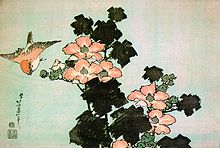 The c. 1830 woodblock "Hibiscus and Sparrow" by the Japanese artist Hokusai, which portrays the Russet Sparrow
The c. 1830 woodblock "Hibiscus and Sparrow" by the Japanese artist Hokusai, which portrays the Russet Sparrow
The Russet Sparrow's breeding season is short, lasting about three months. The Himalayan subspecies cinnamomeus has been recorded breeding from April to August, the nominate subspecies breeds from May to July, and the subspecies intensior is believed to breed in March.[40] During its breeding season, the Russet Sparrow is not gregarious, and its nests are dispersed uniformly rather than clustered. Its nests are most frequently built in tree cavities, often disused woodpecker nests.[40][41] The Russet Sparrow has been recorded breeding alongside the Eurasian Tree Sparrow and White Wagtail in Black Kite nests, taking advantage of the territorial defence of the kites to avoid nest predation.[42] Other nest locations include the eaves of thatched roofs, stone walls and embankments, and electric junction boxes.[40] In Bhutan, it nests in holes in the outer walls of monasteries, often alongside the Eurasian Tree Sparrow.[15] In Sakhalin, it will sometimes build free-standing nests in bushes. The Russet Sparrow also uses the disused nests of the Red-rumped Swallow, and a pair of Russet Sparrows has been recorded attempting to oust a pair of Black-crested Tits from their nest.[40]
The male chooses the nest site, and uses it for his courtship display, spending much time calling nearby. When a female comes near a male at his nest the male begins to display by raising his head, drooping his wings, pushing his chest forward, and lowering his tail. He then bows up and down in front of the female, who will lunge and then fly away if unreceptive.[40] Both sexes take part in building the nest, which consists of a loose, untidy bunch of dry grass which fills the nesting cavity, lined with fur and feathers for warmth.[15][40][43] Eggs are elongated ovals, with a fine texture and a slight gloss. They are whitish in overall colour with a grey tinge and brown spots, streaks, or blotches.[43][44] The average size of the egg is 19.2×14.2 millimetres (0.75×0.55 in).[8] Eggs are similar to those of the Eurasian Tree Sparrow, differing in a duller colour and more narrow shape,[8] though they cannot be separated from those of the other sparrows with certainty.[45] Two clutches of four or sometimes five or six eggs are laid in a year.[40] In Hokkaidō, clutches are laid between early May and early July, with two peaks in laying around mid May and late June.[31] Both sexes incubate and feed the young, with the male often being more active in feeding the nestlings.[40] In Hokkaidō, nestlings hatch weighing about 2 to 5 grams (0.071 to 0.18 oz), and fledge fourteen or fifteen days after hatching, weighing 15 to 55 grams (0.53 to 1.9 oz).[31] The Common Cuckoo has been recorded in old literature as a brood parasite of the Russet Sparrow.[46]
Relationships with humans
In parts of the range, the Russet Sparrow inhabits towns, and in most of its range, it occurs near cultivation, and is a minor pest of agriculture. Though it damages crops, it also feeds its nestlings largely on insect pests.[33][34] In China, the Russet Sparrow has been recorded as a captive bird, kept with the Eurasian Tree Sparrow.[35] In Japan it was eaten in the 1870s and sold in the Yokohama game market.[47] The Russet Sparrow is known well enough in the Himalayas that in most languages it has a different vernacular name from the Eurasian Tree Sparrow. Examples of these vernacular names include lal gouriya in Hindi and kang-che-go-ma in Tibetan.[48] The Japanese artist Hokusai portrayed the Russet Sparrow, and due to this, it has appeared on postage stamps featuring Japanese art in Japan, The Gambia, and Guyana.[49]
References
- ^ a b c "Passer rutilans". IUCN Red List of Threatened Species. Version 2009.2. International Union for Conservation of Nature. 2009. http://www.iucnredlist.org/apps/redlist/details/149104.
- ^ a b c d e f g h i j k l m Clement, Harris & Davis 1993, pp. 450–451
- ^ a b c d e f g h i Summers-Smith 1988, p. 206
- ^ a b c Summers-Smith, J. Denis (2009). "Family Passeridae (Old World Sparrows)". In del Hoyo, Josep; Elliott, Andrew; Christie, David. Handbook of the Birds of the World. Volume 14: Bush-shrikes to Old World Sparrows. Barcelona: Lynx Edicions. ISBN 978-84-96553-50-7.
- ^ a b c d e f g h i j k Summers-Smith 1988, pp. 206–210
- ^ a b Gee & Moffet 1917, p. 210
- ^ Clement, Harris & Davis 1993, p. 4
- ^ a b c Baker 1926, p. 181
- ^ Vaurie, Charles; Koelz, Walter (1949). "Notes on some Ploceidae from western Asia". American Museum Novitates 1406: 1–41. http://digitallibrary.amnh.org/dspace/handle/2246/2345. Retrieved 16 November 2009.
- ^ a b c d e f g h i j k Summers-Smith 1988, p. 214
- ^ Perreau, G. A. (1910). "Change of Plumage in the Cinnamon Tree-Sparrow (Passer cinnamomeus)". Journal of the Bombay Natural History Society XIX (4): 986–988. http://www.archive.org/stream/JBNHS19_4#page/n212/mode/1up.
- ^ Jerdon 1863, p. 365
- ^ Oates 1890, p. 241
- ^ a b Flint et al. 1984, pp. 295–296
- ^ a b c d e Ali & Ripley 1999, pp. 78–79
- ^ Jobling 2009, p. 344
- ^ Meinertzhagen, R. (1951). "Some relationships between African, Oriental, and Palearctic genera and species, with a review of the genus Monticola". The Ibis 93 (3): 443–459. doi:10.1111/j.1474-919X.1951.tb05445.x.
- ^ a b Allende, Luis M.; Rubio, Isabel; Ruíz-del-Valle, Valentin; Guillén, Jesus; Martínez-Laso, Jorge; Lowy, Ernesto; Varela, Pilar; Zamora, Jorge; Arnaiz-Villena, Antonio (2001). "The Old World sparrows (genus Passer) phylogeography and their relative abundance of nuclear mtDNA pseudogenes" (PDF). Journal of Molecular Evolution 53 (2): 144–154. PMID 11479685. Archived from the original on 21 July 2011. http://web.archive.org/web/20110721034443/http://chopo.pntic.mec.es/~biolmol/publicaciones/Passer.pdf.
- ^ González, Javier; Siow, Melanie; Garcia-del-Rey, Eduardo; Delgado, Guillermo; and Wink, Michael (2008). "Phylogenetic relationships of the Cape Verde Sparrow based on mitochondrial and nuclear DNA" (PDF). Systematics 2008, Göttingen. Archived from the original on 22 July 2011. http://www.webcitation.org/60N0MqHpN.
- ^ Summers-Smith 1988, pp. 279–280, 288–290
- ^ Rand & Fleming 1957, pp. 200–201
- ^ Bangs, Outram (1930). "Types of Birds Now in the Museum of Comparative Zoölogy". Bulletin of the Museum of Comparative Zoölogy at Harvard College, in Cambridge LXX. http://www.archive.org/stream/bulletinofmuseum70harv#page/416/mode/1up.
- ^ Gould, J. (1836). "Characters of several New Species of Insessorial Birds, including a New Genus (Stenorhynchus)". Proceedings of the Zoological Society, London (XXXVI): 185–187. http://biodiversitylibrary.org/page/12859947.
- ^ Robson 2004, p. 125
- ^ a b Roberts 1992, pp. 480–481
- ^ Fujimaki, Yuzo (1988). "Breeding Bird Community of a Quercus mongolica Forest in Eastern Hokkaido, Japan". Japanese Journal of Ornithology 37 (2): 69–75. doi:10.3838/jjo.37.69.
- ^ Fujimaki, Yuzo (1986). "Breeding Bird Community in a Deciduous Broad-leaved Forest in Southern Hokkaido, Japan". Japanese Journal of Ornithology 35 (1): 15–23. doi:10.3838/jjo.35.15.
- ^ Peh, Kelvin S.-H. (2007). "Potential Effects of Climate Change on Elevational Distributions of Tropical Birds in Southeast Asia". The Condor 109 (2): 437–441. doi:10.1650/0010-5422(2007)109[437:PEOCCO]2.0.CO;2.
- ^ a b c d e Summers-Smith 1988, pp. 210–211
- ^ a b Chae, Hee-Young (1997). "Feeding Behavior of the Russet Sparrow Passer rutilans in Two Different Habitats" (PDF). Korean Journal of Ecology 20 (6): 405–411. Archived from the original on 24 September 2011. http://www.webcitation.org/61wRn1dxy.
- ^ a b c d Chae, Hee-Young (1997). "Variations in Fledging Body Weight and Wing Length of Russet Sparrow Passer rutilans in Two Different Habitats". Japanese Journal of Ornithology 45 (4): 215–225. doi:10.3838/jjo.45.215.
- ^ Summers-Smith 1988, pp. 214–215
- ^ a b c Summers-Smith 1992, pp. 100–103
- ^ a b c d Summers-Smith 1988, pp. 211–212
- ^ a b Vaughan & Jones 1913, pp. 168–169
- ^ Tung, K. C. ; Liu, J. S.; Cheng, F. P.; Yang, C. H.; Tu, W. C.; Wang, K. S.; Shyu, C. L.; Lai, C. H.; Chou, C. C.; and Lee, W. M. (2007). "Study on the species-specificity of Isospora michaelbakeri by experimental infection". Acta Veterinaria Hungarica 55 (1): 77–85. doi:10.1556/AVet.55.2007.1.8. PMID 17385558.
- ^ Hori, Koji; Isawa, Mitsuhiro; Ogawa, Ryu (1990). "Biology of Two Species of the Protocalliphora (Diptera: Calliphoridae) in Tokachi, Hokkaido, Japan: Feeding Behaviour of Larvae, Larval and Pupal Durations, Voltinism and Host Specificity" (PDF). Applied Entomology and Zoology 25 (4). http://www.journalarchive.jst.go.jp/jnlpdf.php?cdjournal=aez1966&cdvol=25&noissue=4&startpage=475&lang=en&from=jnlabstract. Retrieved 2 March 2010.
- ^ Hori, Koji; Isawa, Mitsuhiro (1988). "Biology of Two Species of the Protocalliphora (Diptera: Calliphoridae) in Tokachi, Hokkaido, Japan: Relationship between the Occurrence and Three Species of Host Birds" (PDF). Applied Entomology and Zoology 23 (3): 298–303. http://www.journalarchive.jst.go.jp/jnlpdf.php?cdjournal=aez1966&cdvol=23&noissue=3&startpage=298&lang=en&from=jnlabstract. Retrieved 2 March 2010.
- ^ Price, Roger D. (15 July 1975). "The Menacanthus eurysternus Complex (Mallophaga: Menoponidae) of the Passeriformes and Piciformes (Aves)". Annals of the Entomological Society of America 68 (4): 617–622. http://www.ingentaconnect.com/content/esa/aesa/1975/00000068/00000004/art00003.
- ^ a b c d e f g h Summers-Smith 1988, pp. 212–14
- ^ Kotaka, Nobuhiko; and Matsuoka, Shigeru (2002). "Secondary users of Great Spotted Woodpecker (Dendrocopos major) nest cavities in urban and suburban forests in Sapporo City, northern Japan". Ornithological Science 1 (2): 117–122. doi:10.2326/osj.1.117. http://wwwsoc.nii.ac.jp/osj/english/activities/ornith_science/ornsci1_1pdfs/os010202.pdf.
- ^ Takagi, Masaoki; and Takahashi, Mitsuhiko. "Three passerine birds bred in the nests of black kites". Strix 15: 127–129. http://www.wbsj.org/nature/public/strix/15/Strix15_16.pdf. Retrieved 4 March 2010.
- ^ a b Hume & Oates 1890, pp. 164–165
- ^ Whistler 1949, p. 229
- ^ Ogilvie-Grant 1912, pp. 206–207
- ^ Lowther, Peter E. (25 November 2009). "Host list of avian brood parasites 2: Cuculiformes; Cuculidae". http://fm1.fieldmuseum.org/aa/Files/lowther/OWcList.pdf. Retrieved 4 March 2010.
- ^ Blakiston & Pryer 1878, p. 244
- ^ Anonymous (1998). "Vernacular Names of the Birds of the Indian Subcontinent" (PDF). Buceros 3 (1). Archived from the original on 1 April 2010. http://web.archive.org/web/20100401015111/http://www.bnhsenvis.nic.in/pdf/vol%203%20(1).pdf.
- ^ Scharning, Kjell. "Russet Sparrow stamps". Theme Birds on Stamps. http://www.birdtheme.org/mainlyimages/index.php?spec=2200&code=118. Retrieved 25 February 2010.
- Works cited
- Ali, S.; Ripley, S. Dillon (1999). Handbook of the birds of India and Pakistan, together with those of Bangladesh, Nepal, Bhutan, and Sri Lanka. 10 (2nd ed.). Delhi: Oxford University Press. ISBN 0195659430.
- Baker, E. C. Stuart (1926). Fauna of British India: Birds. III (2nd. ed.). London: Taylor and Francis. http://www.archive.org/details/BakerFbiBirds3.
- Blakiston, T.; Pryer, H. (July 1878). "A Catalogue of the Birds of Japan". The Ibis. 4 2. http://www.biodiversitylibrary.org/page/8518291.
- Clement, Peter; Harris, Alan; Davis, John (1993). Finches and Sparrows: an Identification Guide. Princeton, New Jersey: Princeton University Press. ISBN 0-691-03424-9.
- Flint, Vladimir E.; Boehme, R. L.; Kostin, Y. V.; Kuznetsov, A. A. (1984). A Field Guide to the Birds of the USSR including Eastern Europe and Central Asia. Princeton, New Jersey: Princeton University Press.
- Gee, N. Gist; Moffet, Lacy I. (1917). A Key to the Birds of the Lower Yangtse Valley, with Popular Descriptions of the Species Commonly Seen. Shanghai: Shanghai Mercury. http://www.biodiversitylibrary.org/bibliography/8675.
- Hume, Allan O.; Oates, Eugene William (1890). The Nests and Eggs of Indian Birds. II (2nd. ed.). London: R. H. Porter. http://www.archive.org/details/nestseggsofindia02humerich.
- Jerdon, T. C. (1863). The Birds of India; Being a Natural History of All the Birds Known to Inhabit Continental India, with Descriptions of the Species, Genera, Families, Tribes, and Orders, and a Brief Notice of such Families as are not found in India, making it a Manual of Ornithology Specially Adapted for India. II—Part I. Calcutta: Military Orphan Press. http://www.archive.org/details/birdsofindiabein21jerd.
- Jobling, James A. (2009). Helm Dictionary of Scientific Bird Names. London: Christopher Helm. ISBN 1408125013.
- Oates, Eugene W. (1890). Fauna of British India, including Ceylon and Burma: Birds. II. London: Taylor and Francis. http://www.biodiversitylibrary.org/bibliography/25658.
- Ogilvie-Grant, W. R. (1912). Catalogue of the collection of birds' eggs in the British museum (Natural history) Volume V: Carinatæ (Passeriformes completed). London: Trustees of the British Museum (Natural History). http://books.google.com/?id=t8VRAAAAMAAJ.
- Rand, Austin L.; Fleming, Robert L. (1957). "Birds from Nepal". Fieldiana: Zoology 41 (1). http://www.archive.org/details/birdsfromnepal411rand.
- Robson, Craig (2004). A Field Guide to the Birds of Thailand. New Holland Press. ISBN 1-84330-921-1.
- Roberts, Tom J. (1992). The Birds of Pakistan. Volume 2: Passeriformes: Pittas to Buntings. Oxford University Press. ISBN 0195774051.
- Summers-Smith, J. Denis (1988). The Sparrows: a study of the genus Passer. illustrated by Robert Gillmor. Calton, Staffs, England: T. & A. D. Poyser. ISBN 0-85661-048-8.
- Summers-Smith, J. Denis (1992). In Search of Sparrows. illustrated by Euan Dunn. London: T. & A. D. Poyser. ISBN 0-85661-073-9.
- Vaughan, R. E.; Jones, K. H. (1913). "On the Birds of South-eastern China IV". The Ibis. 10 1. http://www.biodiversitylibrary.org/page/26514390.
- Whistler, Hugh (1949). Popular Handbook of Indian Birds (4th. ed.). London: Gurney and Jackson. http://www.archive.org/details/popularhandbooko033226mbp.
External links
- Russet Sparrow at the Internet Bird Collection
- Recording of the Russet Sparrow's calls
Sparrows (family: Passeridae) Genus Passer Saxaul Sparrow • House Sparrow • Spanish Sparrow • Italian Sparrow • Sind Sparrow • Somali Sparrow • Russet Sparrow or Cinnamon Sparrow • Plain-backed Sparrow or Pegu Sparrow • Dead Sea Sparrow • Great Sparrow • Socotra Sparrow • Abd al-Kuri Sparrow • Kenya Sparrow • Kordofan Sparrow • Shelley's Sparrow • Iago Sparrow • Cape Sparrow • Northern Grey-headed Sparrow • Swainson's Sparrow • Parrot-billed Sparrow • Swahili Sparrow • Southern Grey-headed Sparrow • Desert Sparrow • Eurasian Tree Sparrow • Sudan Golden Sparrow • Arabian Golden Sparrow • Chestnut Sparrow • Passer predomesticusPetronia Carpospiza Montifringilla
(snowfinches)Categories:- IUCN Red List least concern species
- Passer
- Birds of Asia
- Birds of Nepal
- Birds of Pakistan
- Birds of India
- Animals described in 1835
Wikimedia Foundation. 2010.


